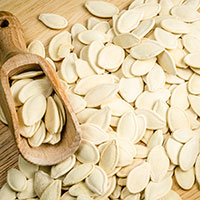| Mineral name |
Phosphorus |
| What’s it used for? | For bones and teeth, forms part of the energy molecule, ATP, used in most biochemical reactions in the body. |
| Best food sources | Seeds, meat, fish, poultry, dairy, whole grains |
| How much do I need? | Nutrient Reference Value (NRV) is 700 mg per day* |
| Need to know | Phosphorus is the second most abundant element in the body after calcium |
*A Nutrient Reference Value or NRV is the recommended level set by the UK Department of Health for daily nutrient intake
Phosphorus
Phosphorus is present in every body cell, although 85% is found in the bones and teeth, working closely with calcium. The calcium/phosphorus ratio is very tightly controlled and the two may compete for absorption. A diet high in fizzy drinks which contain phosphoric acid, can imbalance calcium.
Why do I need it?
Since it’s found in all cells in the body, phosphorus is therefore involved at some level in most biochemical reactions. For example, it provides the phosphate in the energy-producing molecule, ATP. It also helps in the utilisation of carbohydrates and fats for energy production and also in protein for maintenance, growth and repair.
Phosphorus is a component of phospholipids which are essential to cell membranes, and it also helps kidney function. Controlling the acid-base balance in the body is an essential part of regulating the heartbeat.
Best food sources
Since phosphorus is found in all cells, it is more readily available in animal proteins, especially meat and fish. Fruits and vegetables contain some, and help balance the phosphorus to calcium ratio.
Five foods high in phosphorus

Pumpkin seeds – 1233mg per 100g

Cheese – 760mg per 100g

Salmon – 371mg per 100g

Pork – 311mg per 100g

Beef – 286mg per 100g
Are you getting enough?
Deficiency of phosphorus is not generally found since it is widely available in a variety of foods. However, a low intake of vitamin D, which also works in tandem with phosphorus, can create more of a need. A diet that is very high in calcium may create an imbalance, as can taking antacid medication.
Any deficiency symptoms would generally affect the skeletal frame, presenting as bone pain, poor growth in children, tooth decay and stiff joints. However, weight loss, and irritability may also be noted.
A low calcium to phosphorus ratio can be a factor in osteoporosis.
Did you know?
Fizzy drinks are high in phosphoric acid, creating a need for calcium to buffer the acidity and potentially causing a calcium deficiency. Calcium/phosphorus balance is critical in the body.It is safe to take during pregnancy and breast feeding at recommended dosages – consult your healthcare professional for advice.
Rebalancing the calcium/phosphorus ratio can help reduce stress in the body.
The role of phosphorus in ATP production is critical in DNA synthesis and repair.
Try this
Phosphorus is found in the Alive! range of multi vitamins and minerals.
For more information visit www.feelaliveuk.com
You can also follow Alive! on Twitter for general health and wellbeing tips: @feelaliveuk


